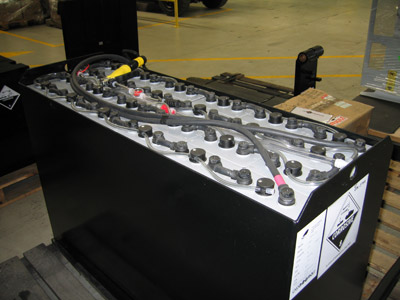Forklift Batteries Maintenance - Make Your Battery Last: Part 1
“Make Your Battery Last” is a two part series to educate you on the basics of forklift battery maintenance. In part one, we will discuss charging and maintaining a forklift battery and then continue through to part two, covering cleaning and safety with a quick summary to finish off.

A few fun facts before we begin:
- Each charge takes a cycle out of a battery. Most new batteries start with 1500 cycles prior to the end of its usable battery life.
- A battery charged once each working day (300 per year) will last 5 years (1500 cycles). Opportunity charging (mentioned below) can reduce the life by over half.
- “Remember, the battery is the fuel tank of the forklift. Look after it and it will look after you.”
Battery maintenance is an extremely forgotten yet important factor; as knowing a little about forklift maintenance will go a long way. It’s a major factor that contributes to costs, safety and the forklift’s life. A significant percentage of forklifts are powered electronically; with the batteries in these machines being very expensive. Therefore proper maintenance and care is necessary to lengthen the life span of your forklift and its battery. The key benefits your business will experience from being involved in a battery maintenance schedule include:
- Decreasing expenses
- Improved safety
- Greater performance
- Extended life span
Re charging/charging
Forklift batteries are designed for long life; given the significant usage levels they are put under. Even though they are designed for a long life, it is up to the user to ensure that proper charging occurs so the battery performs as it was designed to. Constant neglect and bad treatment will only end in increased expenses.
Do’s
- Every five to ten charge cycles, you should select equalise/weekend charge option. Each battery benefits from this by keeping the cell voltages even and in line.
- It is recommended in most applications that you charge a battery at the end of each 8hr shift or if it is discharged more than 30%.
- Always charge a battery in a well ventilated area
Don’t
- Don’t over-discharge (discharge beyond 80%) the battery. This will significantly reduce the life expectancy of the battery.
- Don’t let a discharged battery sit there for extended periods. This will promote hard sulphation and significantly reduce the run time and life of the battery.
- Do not opportunity charge (i.e. charging during lunch breaks) Remember, each charge costs a cycle. If you charge your battery twice a day you will still get your 1500 cycles, but the will be used up in 2.5 years instead of 5.
- Never interrupt a charge cycle if it is unnecessary. It is suggested that once a charge has started, it be allowed to finish.
Fluid Levels
Simple self maintenance can be great for gaining general knowledge about your forklift battery, not to mention increased life time and savings. When dealing with fluid levels of a forklift battery there are a few things you need to keep in mind:
- Check water levels and top up appropriately every 10 or so charges for the first few years. If it is a reconditioned battery you may need to do this every 5 charges. If the battery needs to be toped up, only do a sufficient amount to cover the plastic element protector by roughly ¼ of an inch. The additional space is needed for expansion while gassing at the end of the charge.
- Most batteries now have Single Point Watering kits fitted. These must also be topped up at the end of charge, never before.
- Top up battery with clean water after charging only. Never top it up before beginning a charge.
- Check two or three pilot cells every 5 or so charges to check that the fluid level is above the perforated plastic element protector after charge.
- Never over fill as it will cause overflow on the next charge. An acid loss will inevitably shorten overall running time, can cause overheating and will require a shop service to rectify.
We hope you have grasped the basics and benefits of forklift battery maintenance and can now put some simple measures in place.